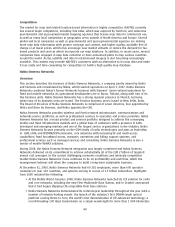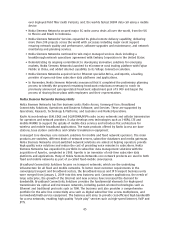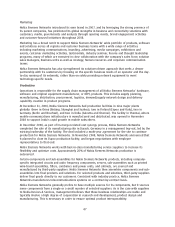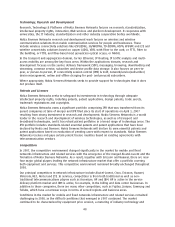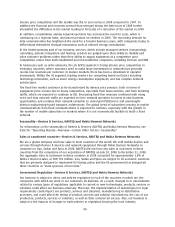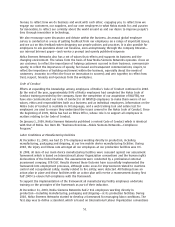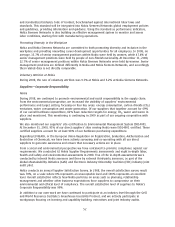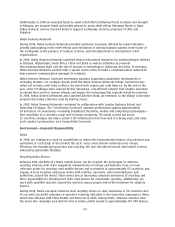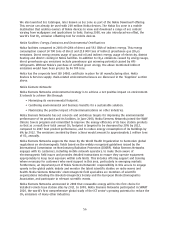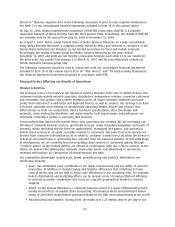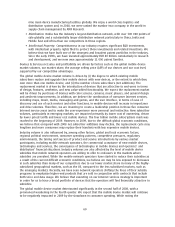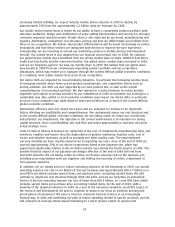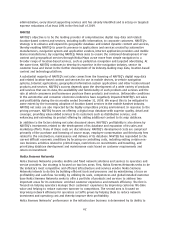Nokia 2008 Annual Report Download - page 54
Download and view the complete annual report
Please find page 54 of the 2008 Nokia annual report below. You can navigate through the pages in the report by either clicking on the pages listed below, or by using the keyword search tool below to find specific information within the annual report.Nokia Siemens Networks
All Nokia Siemens Networks suppliers must meet Nokia Siemens Networks’ global supplier
requirements, which set standards for the management of ethical, environmental and social issues.
This commitment is part of the contractual agreements with the suppliers.
To monitor our suppliers, Nokia Siemens Networks conducts regular audits to identify risks, monitor
compliance and raise awareness of its requirements, and shares best practice on CR management. In
2008, Nokia Siemens Networks carried out 103 system audits to assess compliance with its supplier
requirements. Nokia Siemens Networks also conducted indepth labor conditions audits of seven
suppliers in China, India and the UK.
The annual Nokia Siemens Networks supplier satisfaction survey was conducted with 290 key
suppliers. This survey showed ‘business ethics and environment’ as the area on which Nokia Siemens
Networks scored best, obtaining an overall score of 8.3 (scale 110). Based on the feedback of this
survey, Nokia Siemens Networks considers that the basic requirements are understood well by the
majority of its suppliers, and that suppliers find the requirements to be strict.
In early 2008, Nokia Siemens Networks also conducted a survey on the compliance to its requirement
on Environmental Management System (EMS) among its direct suppliers. The survey showed that 91%
of suppliers’ sites had a documented EMS in place, and the majority of these were also certified.
Nokia Siemens Networks also continues to work in collaboration with others in our industry to
improve standards in the ICT supply chain through groups such as the GeSI.
Society—
Corporate Responsibility
Nokia
In 2008, Nokia continued to develop mobile datagathering technology, aimed at helping
organizations to collect field data without the use of paper forms. Intended primarily to assist non
profit organizations and government departments, this approach increases the speed of response
time, increases efficiency and can reduce costs. In September 2008, the Nokia Data Gathering solution
was launched in conjunction with its adoption by the Amazonas State Health Department in Brazil. In
that case, the software is being used to monitor outbreaks of disease and the effectiveness of
prevention programs in the city of Manaus.
During 2008, we continued to support a variety of youth development initiatives around the world,
with activities underway in 57 countries. These projects are tailored to the needs of local
communities and address issues such as education, employability and health, and encourage young
people to contribute to their local communities. Nokia employees continued to give their time to
community projects through the Nokia Helping Hands employee volunteering program. In 2008, more
than 5 400 employees in 25 countries volunteered more than 34 000 hours of service.
In March 2008, the success of the Bridgeit youth education project in the Philippines was reflected in
its renewal and expansion. Originally launched in 2003, Bridgeit uses mobile networks to bring
interactive multimedia learning materials to schools that lack fixed internet connections or ready
access to the latest educational materials. Through this partnership with International Youth
Foundation, Pearson and the United Nations Development Programme, Nokia estimates that
approximately one million elementary school children have benefited from the program to date.
During the year, Nokia continued to provide assistance to people affected by natural disasters. This
assistance included the donation of funds and mobile phones to assist relief efforts following an
earthquake in the Sichuan province of China and the donation of funds to assist relief efforts in the
wake of Cyclone Nargis in Myanmar. Our support for cyclone victims in Myanmar has included a
substantial sum raised through a UNICEF greetings card campaign. We have also committed to
support the longterm reconstruction of the affected areas in both Myanmar and Sichuan province.
53



